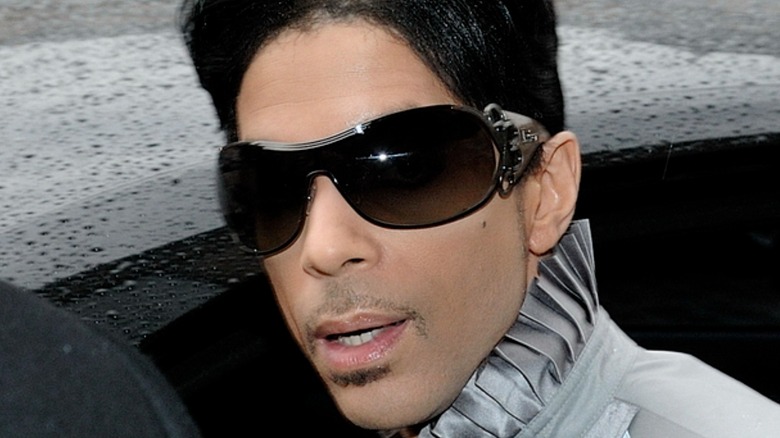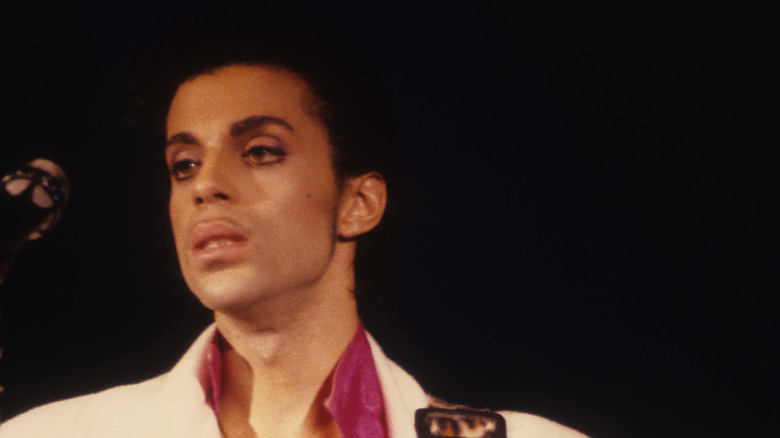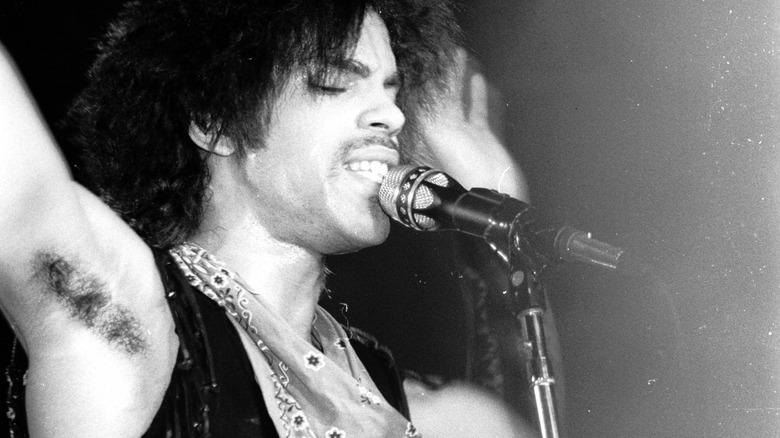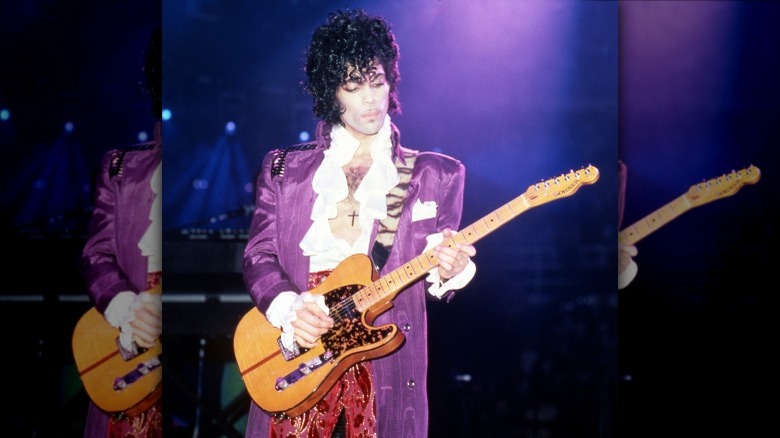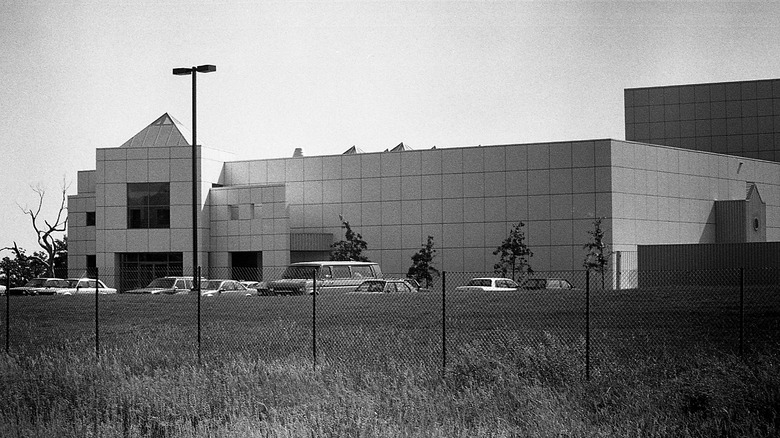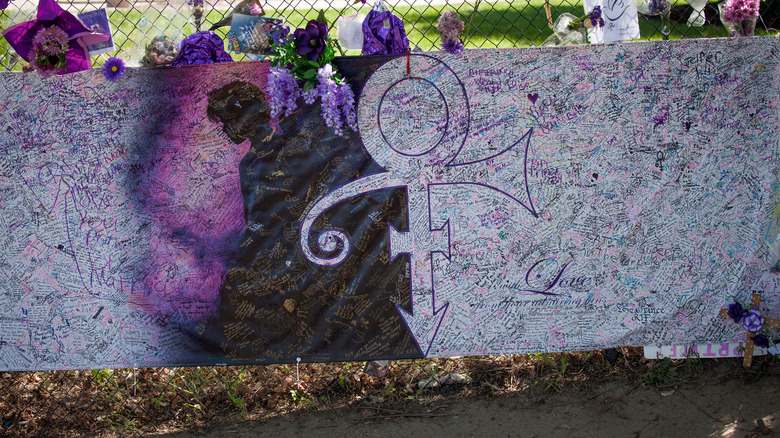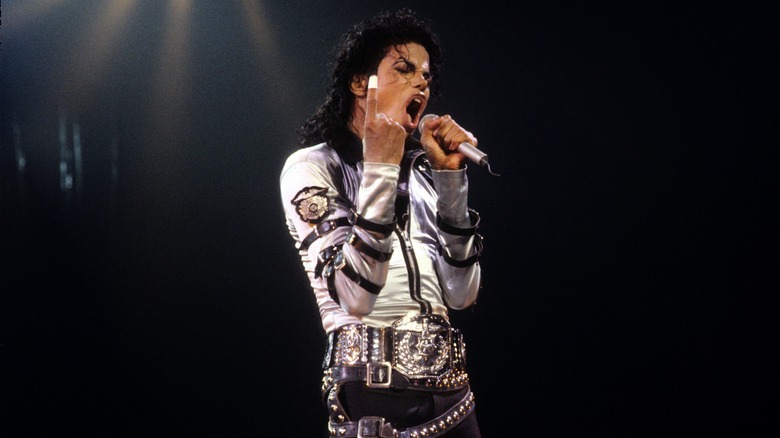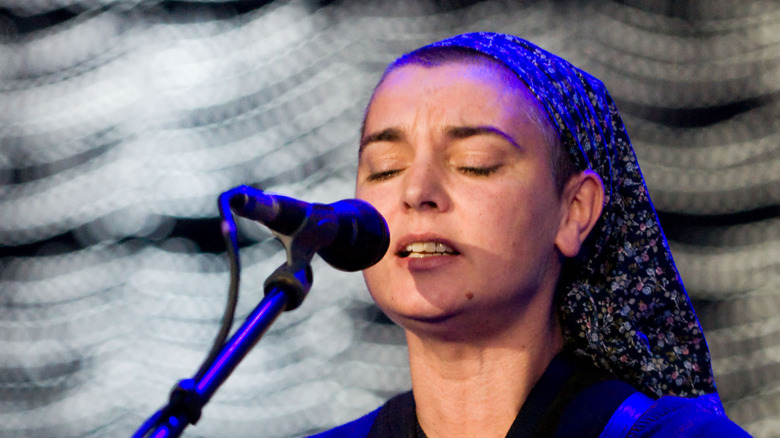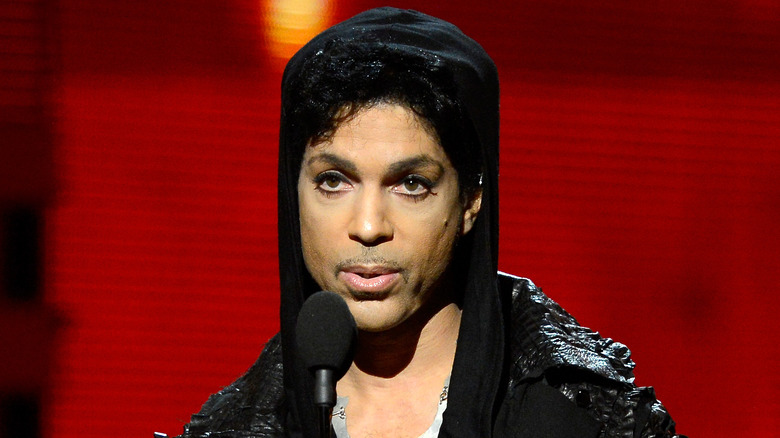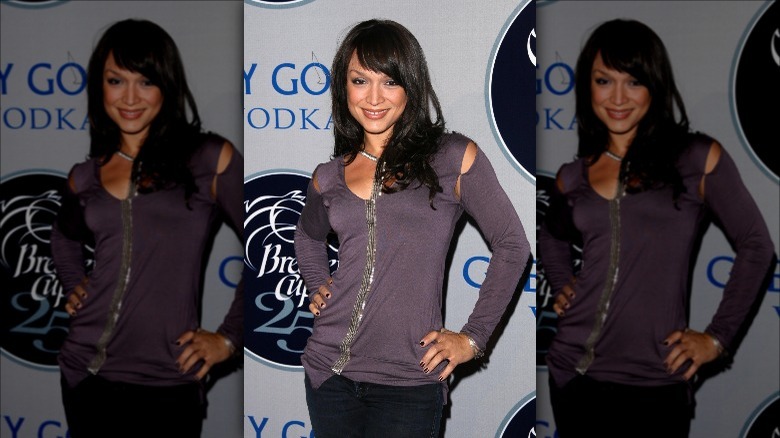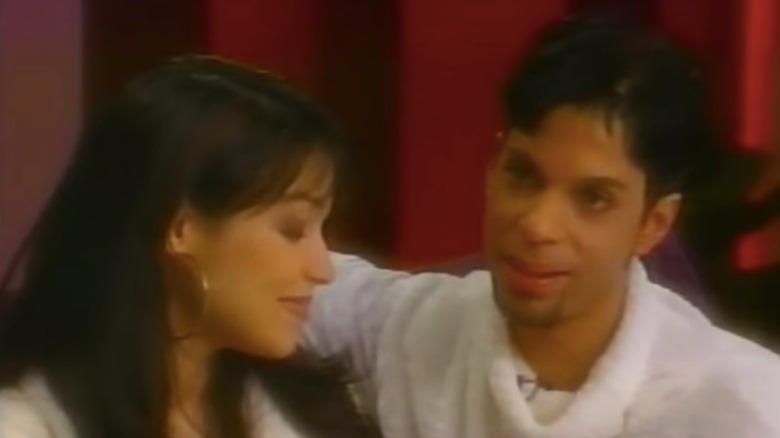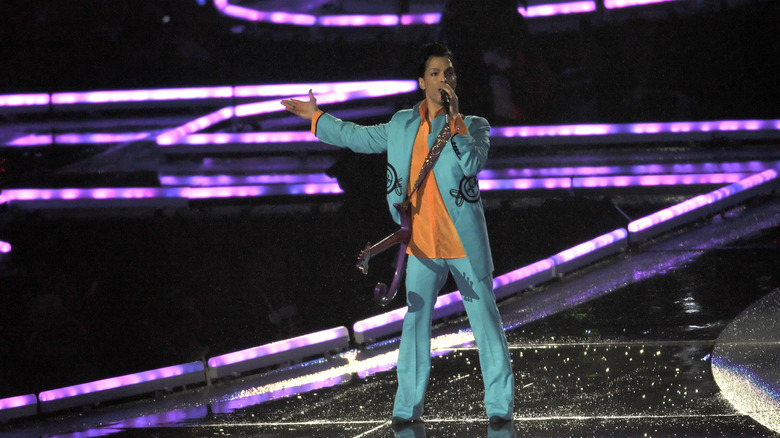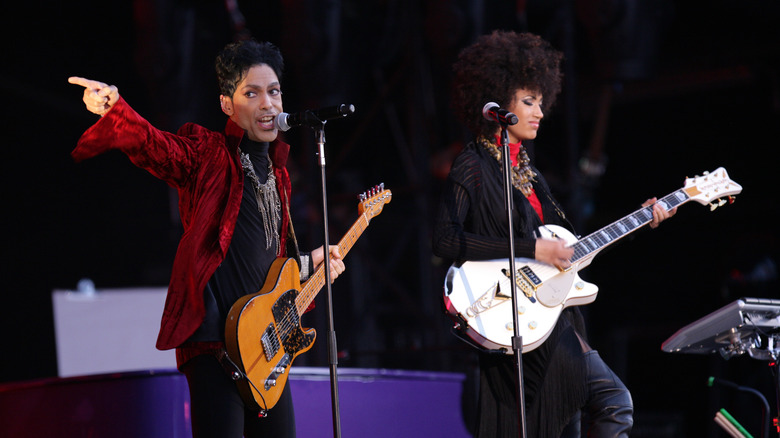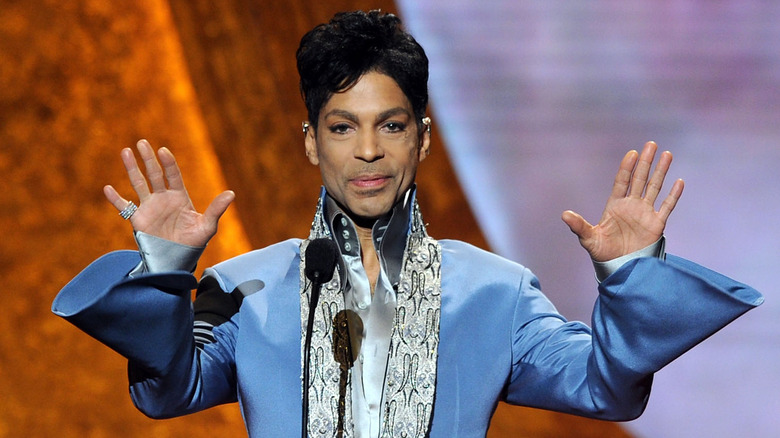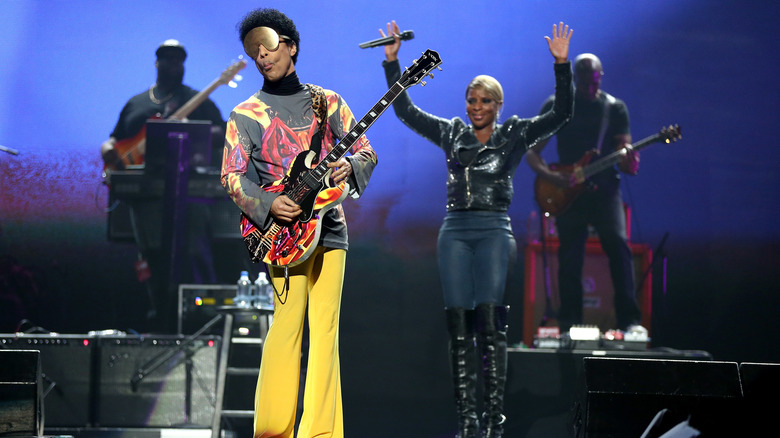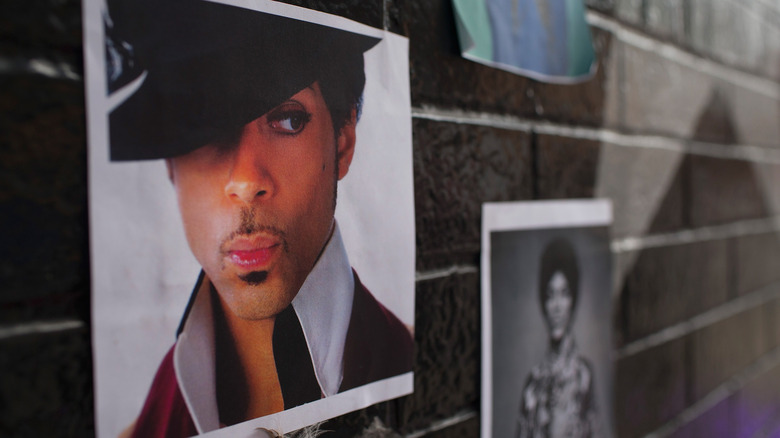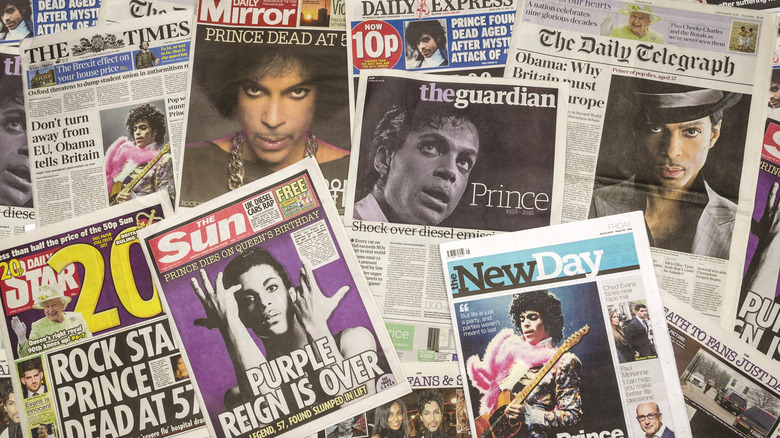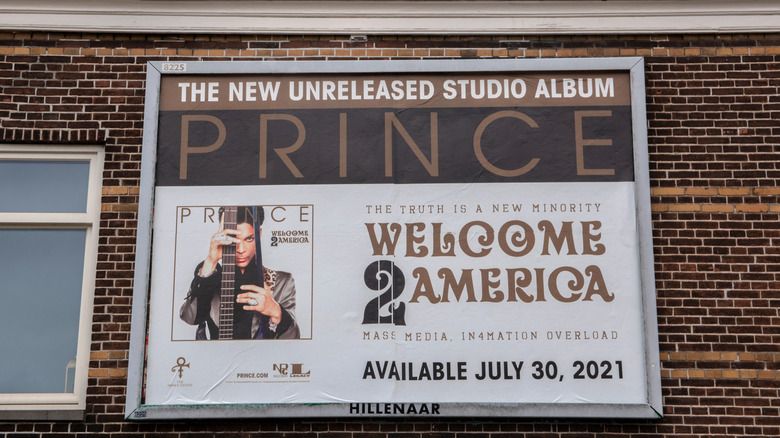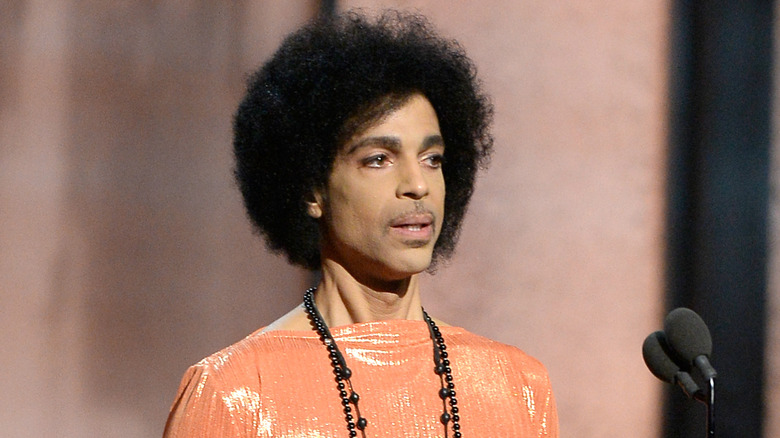The Untold Truth Of Prince
"I'm not a woman, I'm not a man, I am something that you'll never understand," sings the artist Prince Rogers Nelson – best known by the single name Prince, on his 1984 single "I Would Die 4 U." Critics have noted the song – which also contains the lyric "I'm your messiah" – may be written in the voice of Jesus Christ, but which nevertheless works as a manifesto for Prince's own superman indefinability, in both his music and in life.
An intensely private person as well as an unstoppable show-off, a devoted Christian as well as a shocking promotor of the pleasures of the flesh, Prince was a figure whose complications and contradictions kept audiences wrapt throughout a world-beating 40-year career. Since his death in 2016, Prince has been remembered as a pop music master, with many outlets, such as Vulture, lauding him as a bona fide genius.
But the high-flying musician's ascension to stardom seems inevitable in hindsight, Prince's rise was turbulent, and his life was more complicated than his immaculate stage persona would ever suggest. It's time to delve into The Purple One's many ups and downs.
Prince's troubled youth
On the face of it, Prince's childhood home in Minneapolis in many ways offered the perfect environment for his musical development. To begin with, Prince was blessed with a musical family. His mother, Mattie Della Shaw, was a well-respected jazz singer, while his father, John Lewis Nelson, had made a significant impact as a pianist, performing under the name Prince Rogers in a famous trio (per Becoming Prince). However, the future star also suffered numerous traumas which, biographers say, would underpin his transformation into the showman he later became.
But though Prince's father was his great musical inspiration, the two initially had a difficult relationship, with the son feeling unable to play music in his father's presence. Per Becoming Prince, the future star's parents split when he was seven, which had a lasting effect on him: amid the tumult of divorce, Prince desired nothing more than stability in which he could emulate his father's habitual passion for making music. Prince moved around a lot, living for a brief spell with his father following his parents' divorce where he was taught the basics of playing the piano, though he also ran away from home and lived for a time with a neighboring family. However, despite feeling unsettled, the prodigy taught himself to play drums and guitar while still a child, according to Biography.
Despite his later success as a performer, Prince was naturally an introverted child, who suffered bullying at school; he later claimed that it was being teased that made him come out of his shell and show off, per the same source.
How Prince avoided being pigeonholed
Prince began forming bands and performing music for audiences while he was still in high school, and it wasn't before long that the music industry began to take notice. He signed to Warner Bros. Records in 1977 while still a teenager, according to The Guardian, and quickly set about making his mark, releasing a new studio album every year from 1978 until 1982. But as NPR notes, the young musician consciously made creative decisions that would avoid him being pigeonholed as a creator of songs that would only be marketable to a Black audience; in fact, Prince took steps to distance himself from his heritage as the son of two Black parents, remaining ambiguous about his racial identity.
Prince was also looking to create fluidity in all aspects of his life, as he openly admits in his 1981 hit "Controversy," containing the lyric: "Am I Black or white? Am I straight or gay? Controversy." Prince's mixing of religious and profane imagery was also a conscious creative choice that grabbed the attention of audiences and critics.
"[His] process was to isolate two theoretically opposed aspects of a self, of a person — male-female, black-white, straight-gay, good-evil," claims the academic Ben Greenman, whose 2017 book "Dig If You Will the Picture: Funk, Sex, God, and Genius in the Music of Prince" delves deep into the undercurrents that guided Prince and his music. "[H]e played out that opposition in his work. Sometimes he resolved it to his satisfaction; usually, he didn't. And the tension between those two things powered the work. That was the engine at the center." (via NPR)
Six months at the top
Prince's early commercial successes were humble – his debut studio album, "For You," landed high on the Billboard 200 at No. 163 – while the single "Soft and Wet" barely scraped into the Hot 100 at No. 93 – but at the end of his first run of five albums, he finally peaked in the top 10, with the release of 1982's "1999," which went to No. 7. But nothing could prepare Prince – or his fans – for the incredible heights he was about to scale with his next album, the 1984 classic "Purple Rain."
It is no secret that the album was Prince's biggest hit, but it may be difficult to quantify just what a monster the album became in the year of its release. Between August 1984 and January 1985, "Purple Rain" spent a jaw-dropping 24 weeks at the very top of the Billboard 200, while the movie of the same it soundtracked – starring Prince in the lead role – and the album's lead single "When Doves Cry" both hit their respective top spots, establishing Prince as an undeniably dominant pop-culture force (via Rolling Stone).
The album was eventually certified a mind-boggling 13 times platinum, dwarfing his second-highest selling record, "1999," which went four times platinum. It remains one of the best-selling albums of all time and is considered by many critics a defining cultural artifact of the 1980s.
Prince's utopian vision
For a performer known for his eccentric and attention-seeking public persona, it is surprising to learn that Prince was also an artist who appreciated spending a great deal of time alone and who protected his privacy fervently. The singular vision by which Prince was able to realize such works as "Purple Rain" was due to his incredible productivity, which in turn was the result of his finally having found the peace he had searched for as a child: "A quiet space where Eye could hear myself think & create," Prince wrote in his memoir, via Becoming Prince.
Prince started making steps towards his own creative haven after first signing to Warner Bros. when he bought a property just outside of his native Minneapolis. According to Pitchfork, Prince soon dubbed the otherwise anonymous suburban home the Kiowa Trail Home Studio, and painted the outside purple. The house became the setting for much of his creative output, and was the site at which he recorded tracks for some of his best-loved albums, from 1981's "Controversy" to 1987's "Sign O' the Times."
But it was Prince's next Minneapolis residence that would become his true utopia: a $10 million compound and recording studio measuring some 65,000 square feet, according to The New Yorker. Prince first envisioned the paradise – "Paisley Park" – on a 1984 song of the same name, though it would only be in 1987 that his vast project was completed. Originally open to outside artists, within a decade Prince made the compound his private residence, where he could record endlessly to his heart's content.
Why Prince changed his name to a symbol
Though nothing he released ever came close to attaining the heady commercial and critical heights of "Purple Rain" – very few albums in the history of popular music have – Prince continued to enjoy a wide audience and released hit after hit well into the 1990s. However, issues with his longtime record label Warner Bros. derailed his career for the best part of a decade – especially after The Purple One's growing eccentricity saw him labeled in the public eye as something of an oddball.
In 1993, Prince released a statement telling the world that he was no longer going by his stage name, but by a single non-standard sign combining the common symbols representing "man" and "woman," which would later become known as the "love symbol." "It is an unpronounceable symbol whose meaning has not been identified. It's all about thinking in new ways, tuning in 2 a new free-quency" (via Entertainment Weekly). But why?
According to the BBC, Prince had just signed a new deal with Warner Bros. but soon realized that the record label wanted to greatly limit the amount of music Prince released per year to avoid saturating the market. Prince had continued to record at a prolific rate over the years, and already had a backlog of material he wanted to release. The move to becoming "The Artist Formerly Known as Prince" was therefore an attempt to wrest back commercial control of Prince's music. Prince explained: "Warner Bros. took the name, trademarked it, and used it as the main marketing tool to promote all of the music I wrote ... The company owns the name Prince and all related music marketed under Prince. I became merely a pawn used to produce more money for Warner Bros."
Prince's rivalry with Michael Jackson was real
Popular music is full of great rivalries that exist in the minds of fans, but not necessarily in real life. Classic rock fans might hotly debate with each other whether The Beatles or The Rolling Stones was the greater band, though in reality the two groups were close friends and supported each other's music. Similarly, rap listeners' favorite subject is the ongoing discussion about which rap star is truly the Greatest of All Time, even though many of those in the running performed together in a show of unity at the 2022 Super Bowl half-time show.
Arguably, the artist who Prince has been most compared to over the years is another heavy-hitter: the King of Pop himself, Michael Jackson. As The Wrap notes, there are many superficial similarities between the two artists – both men were born in 1958, and both grew up in the Midwest. But their similarities go much deeper: their shared love of genre-blending and -breaking, their incredible showmanship, and the questions they both raised about race and sexual identity, both on record and in their private lives.
Though Prince would later claim that no rivalry existed, as a number of incidents throughout his life make clear there was tension between the artists. Per Slate, one of these involved Jackson inviting Prince on stage at a James Brown concert in 1983 — apparently in the belief that the unprepared musician would embarrass himself — while it is also believed that Prince declined to feature on the charity single "We Are The World" because of Jackson's involvement, and that he turned down the opportunity to feature on his rival's hit song "Bad."
Prince gave away a ton of hits
Though Prince is primarily remembered as a solo artist, he sought to work with other musicians throughout his career, forming a number of bands along the way. Some, like The Revolution and 3RDEYEGIRL, acted as Prince's backing bands, while others, such as The Time and The Family, were bands Prince had formed and signed as outlets for his excess songs. But the songwriter also gave several huge hits away to other acts, such as The Bangles' 1986 classic "Manic Monday," and "Nothing Compares 2 U," a song originally given to The Family before it was covered by Sinead O'Connor (pictured) in 1990, and became a worldwide smash. Prince also wrote well-regarded songs for artists as diverse as Kenny Rogers and Mavis Staples, per CNN.
The strength of Prince's songwriting for other artists become especially noticeable after his death and the posthumous release of the demo compilation "Originals" in 2019. An album featuring self-recorded early versions of 15 huge hits, "Originals" was met with widespread critical acclaim from music journalists such as Pitchfork's Rebecca Bengal, who called it a "testament to his genius."
Why Prince didn't do autographs
What would you do if you heard the doorbell ring, and, when you answered, one of the biggest musicians on the planet was standing there asking if you'd like to talk about God?
Because that seemed to be happening a lot in the 2000s and early 2010s, when numerous news outlets ran stories concerning people having opened their door to Prince around his home state of Minnesota. The reason for this was simple: In 2001, The Purple One became a Jehovah's Witness, having been raised a Seventh Day Adventist, according to Billboard.
It is part of the Jehovah's Witness faith to spread the word of their Church to potential converts, and this was a duty that Prince reportedly performed wholeheartedly, becoming a well-respected member of the Kingdom Hall of Jehovah's Witnesses in St. Louis Park in Minneapolis, according to E! News. But Prince's conversion also had other unexpected consequences for his fans, in that he refused to sign autographs in his later years, as it might be interpreted as a form of worship and therefore disrespectful to God, according to the same source.
The strange circumstances of Prince's first marriage
Prince was linked to many high-profile women during his lifetime, including the actress Kim Basinger – for whose 1989 movie "Batman" Prince wrote the soundtrack – and the singer and model Carmen Electra, though such affairs were generally only reported as "rumors" at the time they were happening (via ET Online).
But though notoriously private when it came to sharing his personal life with the world, there was one relationship that Prince was happy to make public: his love affair with Mayte Garcia, the backing dancer who would eventually become his first wife. Prince was 15 years Garcia's senior and met her – and seeming fell for her – when she was just 16, according to The Irish Times.
However, in her recent memoir about their relationship, Garcia contests that there wasn't anything strange about the early days of their romance, insists that Prince was a perfect gentleman, and commended him for waiting until she was 19 before starting a relationship, per the same source. Per CNN, the couple married in 1996, and in the years that followed Prince was regularly pictured in public with his beautiful young wife on his arm. But though the pairing was idealistic from the outside, it was soon beset by a terrible tragedy.
The tragic death of Amiir Gregory Nelson
Within a year of their getting married, Prince and Mayte Garcia were expecting their first baby. Amiir Gregory Nelson was born October 16, 1996, but tragically, the child suffered from a rare genetic condition: Pfeiffer syndrome type two, which results in, in Garcia's words, "premature fusing of the bones in the skull, sometimes resulting in 'cloverleaf skull,' in which the eyes are outside the sockets," per Vanity Fair. Traumatically, the newborn was subjected to daily surgeries to try and save his life, and was fed through a feeding tube. He died after six days.
Following Amiir's death, Prince and Garcia gave an interview to Oprah, in which the musician gave a tour of the lavish playroom he had prepared at Paisley Park for Amiir's arrival, and avoided answering direct questions about the child's health. Speaking to People, Garcia recalls mourning in bed with Amiir's ashes for days on end, and that eventually, somewhere in the cloud of her grief Prince informed her that he was leaving. They divorced in 2000.
The tragedy had a profound effect on Prince, whose conversion to becoming a Jehovah's Witness occurred in the wake of his son's death. In 2001, he married Manuela Testolini, a charity consultant. It was a union that saw the singer become a "fierce philanthropist," according to Testolini (via Rolling Stone). After his death, Testolini revealed that Prince had supported 15 charities, stating: "He knew that he had the power and the chance to make an impact by leading by example." (per I Love Classic Rock)
The two were married for five years and divorced in 2006. They had no children.
The Super Bowl show was nearly a disaster
While for Prince the 1990s had been dominated by legal disputes and personal tragedy, the 2000s was the decade that the artist performed his glorious – and, it must be said, unexpected – comeback, which saw him catapulted back to the music industry's top table. Per Prince's official website, his resurgence began with the release of 2004's "Musicology," his first album for a major label in six years, which received warm reviews and eventually went double platinum. Prince also made a big splash in 2004 when he performed alongside Beyonce at the Grammys.
But the jewel in the crown of Prince's resurgence undoubtedly came in 2007, when his Super Bowl halftime show reminded an audience of more than 90 million Americans why he was one of the finest – and most unpredictable – performers in the game. Emerging onto his bespoke 'love symbol' stage through a hidden lift shaft to the sound of Queen's "We Will Rock You," Prince broke into a raucous version of "Let's Go Crazy" before interspersing a number of his greatest hits including "1999" and "Purple Rain" with a smattering of classic covers.
By many accounts, the show was nearly a disaster, as the Dolphin Stadium in Miami was hit by a powerful rainstorm. The organizers were worried that the downpour would ruin the show: that the electrics would become dangerous or the slick surface of the stage would become hazardous to Prince and his dancers. Reportedly, Prince's response to the news that he would be performing in a storm was: "Can you make it rain harder?" (via Rolling Stone)
Prince was a conspiracy theorist
As well as the devout religious beliefs that Prince held after joining the Jehovah's Witnesses, Prince also harbored some controversial ideas about the world at large. Per The Guardian, in 2009 the singer admitted that he was an ardent believer of the "chemtrail" conspiracy theory, which claims that the vapor trails left in the sky by commercial jets aren't simply the byproduct of propulsion, but rather poisonous chemicals released into the air by shadowy forces to poison society and affect our movements. "When I was a kid, I used to see these trails in the sky all the time and I'd say, 'Oh, that's cool – a jet just went over.' And then you started to see a whole bunch of them and the next you know, everybody in your neighborhood was fighting and arguing and you didn't know why," Prince explained. The theory has been debunked by scientists.
In the same interview, Prince also discussed his outrage that school children are taught that George Washington was the first president of the United States: "When I found out there were eight presidents before George Washington, I wanted to smack somebody." However, as The Guardian explains, previous to Washington there existed only the role of "president of the Continental Congress," and it was ceremonial in nature.
Per the same source, Prince encountered both of these baseless ideas in the work of the pioneering Black comedian and civil rights activist Dick Gregory, one of Prince's great heroes whose later material sadly included the amplification of many other conspiracy theories, including the idea that Prince was murdered, according to the Kurtz Institute.
Prince rejected streaming services
Today, the role of streaming in the music industry and its effect on artists is a controversial subject. Artists including Taylor Swift, Neil Young, and Joni Mitchell have all made their opinion clear that unfair business practices on the part of streaming companies are negatively impacting professional musicians. But one of the first major artists to make his opposition to the dominance of streaming public was Prince, who until his death severely limited which platforms were free to distribute his work.
Not to say that Prince was a traditionalist. In 2004, the impressive commercial performance of the studio album "Musicology" was assisted by an innovative distribution tactic, in which the record was priced into the cost of each ticket on the lavish 88-date "Musicology" live tour, which put it directly into the hands of 1.47 million attendees, per Prince.com. "What a lot of people don't understand is that Prince was not only one of the greatest creative musical talents of the 20th Century, but he was also one of the greatest music business innovators of the last century," according to the music business management expert John Kellogg, per the BBC.
And as Fortune notes, Prince was also optimistic in the early days of the internet that the new technology could work as an effective distribution tool for artists looking to break out from under the control of record companies. However, with the rise of streaming giants such as Spotify, The Purple One sought to have his music removed from such platforms, only offering exclusive rights to Jay-Z's Tidal in 2015. After his death, Prince's estate reintroduced his discography to all streaming services, reaping enormous profits in the process, according to CNBC.
Prince embraced BLM
As previously noted, in the early days of his career Prince purposefully presented himself as racially ambiguous in a move that critics have interpreted as a step towards accessing a larger listenership in the repressive music industry of the late 1970s and early 1980s. Writing for I Care If You Listen, culture critic Aisha Staggers argues that a change occurred in Prince's racial self-presentation in the 1990s, when during his feud with Warner Bros., he regularly appeared in public with the word "slave" emblazoned on his cheek.
Staggers notes that Prince further embraced his Blackness in the 2010s, following the formation of the Black Lives Matter movement in the wake of the police shooting of Michael Brown – who was unarmed – in Ferguson, Missouri. Prince was quick in endorsing the movement and used his voice to amplify their message. "Does anybody hear us pray for Michael Brown or Freddie Gray?" he sang in "Baltimore," a piece written especially for a BLM protest held in the city, referencing another young Black man who had recently died in police custody.
Prince returned to styling his hair in an afro, as he had done on the cover of his debut album. And presenting an award for album of the year at the 2015 Grammys, Prince made his support of the movement clear, when he stated: "Like books and Black lives, albums still matter. Tonight and always." (via Billboard)
Prince was afraid to die alone
Neal Karlen was one of the journalists Prince trusted the most over the course of his career, giving the writer numerous extended interviews, collaborating with him on projects, and, very often, calling him in the middle of the night to discuss his thoughts, feelings, and fears (per Literary Hub). Karlen knew Prince intimately, and claims the much-loved performer was in reality "one of the loneliest souls I ever met." He also believes that Prince's biggest fear in life was dying alone.
The circumstances of Prince's untimely death are therefore doubly tragic, as the musician was found unresponsive in an elevator at his Paisley Park compound on April 21, 2016. Doctors believed he may have been lying dead for up to six hours. According to USA Today, a cause of accidental death was declared following an autopsy on his body, which found he had overdosed on the opioid fentanyl, as a result of taking counterfeit Vicodin. The singer had suffered from chronic pain for many years, having had hip surgery back in 2010 (per Rolling Stone). He was 57.
The messy aftermath of Prince's death
On the second anniversary of Prince's death, USA Today published a feature angrily lamenting that the investigation into his death had already wrapped up, with no one the wiser as to how the musician came to be in possession of counterfeit Vicodin, or who in his entourage was to blame for the deadly accident. Though search warrants were published detailing the wide range of controlled substances found at Paisley Park in the names of several members of his circle, nobody has ever been charged with a crime in relation to the procurement of the drugs. The case surrounding his death has been effectively closed.
It was revealed following his death that Prince had not left a will, which meant his estate remained disputed years after his death, per USA Today. The administration of his estate, reportedly worth hundreds of millions of dollars, has been publicly disputed by the musician's six siblings, who remain his living heirs, while in 2022 it was revealed that the estate finally settled a long-running dispute with the Internal Revenue Service regarding the valuation of the late singer's assets and the settlement of many millions in unpaid taxes, according to Digital Music News.
Prince's vast music vault
After Prince's death, details began to emerge regarding the legendary "vault" at Paisley Park that housed the musician's trove of unreleased recordings. According to Uncut, the vault contains a vast number of fully-formed albums, some dating back to his creative peak in the 1980s, including a long jam album recorded in 1986 called "The Flesh," and a 1987 work titled "Camille," which was reportedly written and performed from the point of view of the singer's female alter ego.
In the years since his death, a selection of material from the vault has slowly been made public, in the form of the demo album "Piano & A Microphone 1983," released in 2018, and 2021's "Welcome 2 America," as well as the "Originals" compilation. According to Esquire, it is believed that there may be as many as 8,000 unreleased songs in the Paisley Park vault, enough for his estate to continue treating his fans to unheard music for decades to come.
A message of unity
Years on from Prince's untimely death, Prince's fanbase seems as strong as ever, with the posthumous albums released by his estate gaining plenty of attention and sales at the same time that some critics wondered if the publication of the newly uncovered songs constituted a "betrayal" of the notoriously private artist's life work (via The New Yorker). Meanwhile, his many friends and acquaintances have expressed how much he is missed.
His friend Neal Karlen has written how, after years of being satisfied the musician was at peace, he found himself pining for his dead friend and the effective role he played as a Black Lives Matter campaigner in the wake of the murder of George Floyd, who was killed just a few miles from the homes of both Prince and Karlen in Minneapolis (via Literary Hub).
On what would have been Prince's 62nd birthday on June 7, 2020, his estate released a handwritten note that underscored one of the core messages of both his music and his activism: the need for tolerance and acceptance between human beings (per NME). The note reads: "Nothing more ugly in the whole wide world than INTOLERANCE (between) Black, white, red, yellow, boy or girl. INTOLERANCE."
